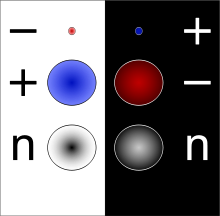
Back Antideeltjie Afrikaans Antiteilchen ALS جسيم مضاد Arabic ضدفرتيتة ARY Antipartícula AST Antizərrəcik Azerbaijani Антычасціца Byelorussian Античастица Bulgarian প্রতিকণা Bengali/Bangla Antipartícula Catalan

| Antimatter |
|---|
 |
In particle physics, every type of particle of "ordinary" matter (as opposed to antimatter) is associated with an antiparticle with the same mass but with opposite physical charges (such as electric charge). For example, the antiparticle of the electron is the positron (also known as an antielectron). While the electron has a negative electric charge, the positron has a positive electric charge, and is produced naturally in certain types of radioactive decay. The opposite is also true: the antiparticle of the positron is the electron.
Some particles, such as the photon, are their own antiparticle. Otherwise, for each pair of antiparticle partners, one is designated as the normal particle (the one that occurs in matter usually interacted with in daily life). The other (usually given the prefix "anti-") is designated the antiparticle.
Particle–antiparticle pairs can annihilate each other, producing photons; since the charges of the particle and antiparticle are opposite, total charge is conserved. For example, the positrons produced in natural radioactive decay quickly annihilate themselves with electrons, producing pairs of gamma rays, a process exploited in positron emission tomography.
The laws of nature are very nearly symmetrical with respect to particles and antiparticles. For example, an antiproton and a positron can form an antihydrogen atom, which is believed to have the same properties as a hydrogen atom. This leads to the question of why the formation of matter after the Big Bang resulted in a universe consisting almost entirely of matter, rather than being a half-and-half mixture of matter and antimatter. The discovery of charge parity violation helped to shed light on this problem by showing that this symmetry, originally thought to be perfect, was only approximate. The question about how the formation of matter after the Big Bang resulted in a universe consisting almost entirely of matter remains an unanswered one, and explanations so far are not truly satisfactory, overall.
Because charge is conserved, it is not possible to create an antiparticle without either destroying another particle of the same charge (as is for instance the case when antiparticles are produced naturally via beta decay or the collision of cosmic rays with Earth's atmosphere), or by the simultaneous creation of both a particle and its antiparticle (pair production), which can occur in particle accelerators such as the Large Hadron Collider at CERN.
Particles and their antiparticles have equal and opposite charges, so that an uncharged particle also gives rise to an uncharged antiparticle. In many cases, the antiparticle and the particle coincide: pairs of photons, Z0 bosons,
π0
mesons, and hypothetical gravitons and some hypothetical WIMPs all self-annihilate. However, electrically neutral particles need not be identical to their antiparticles: for example, the neutron and antineutron are distinct.